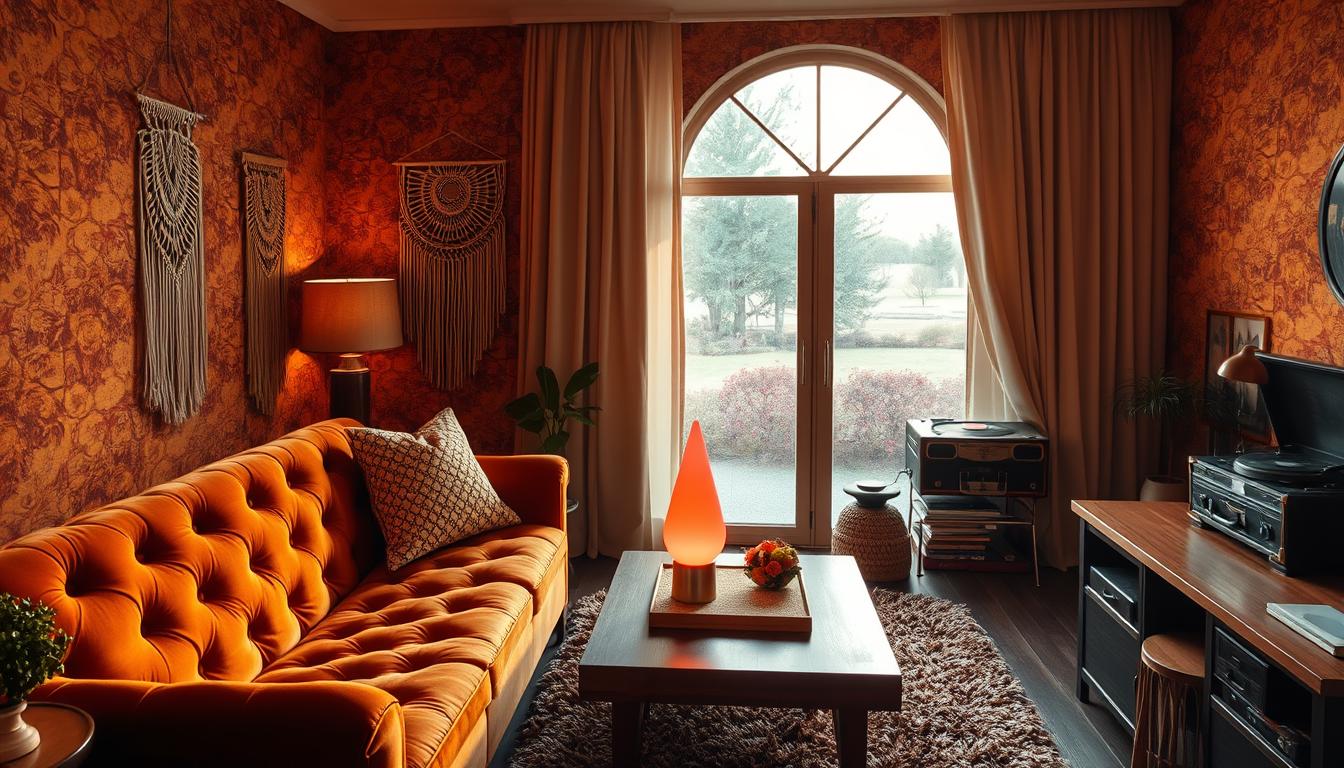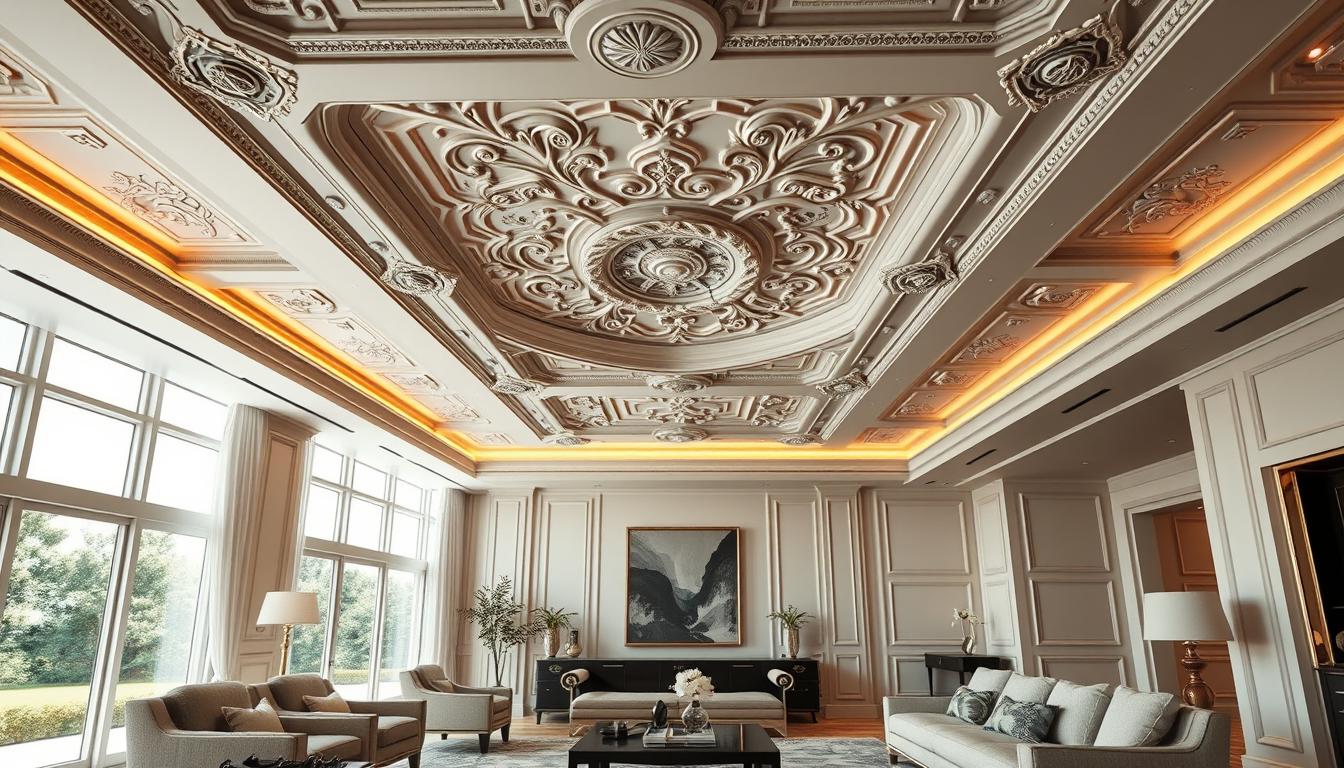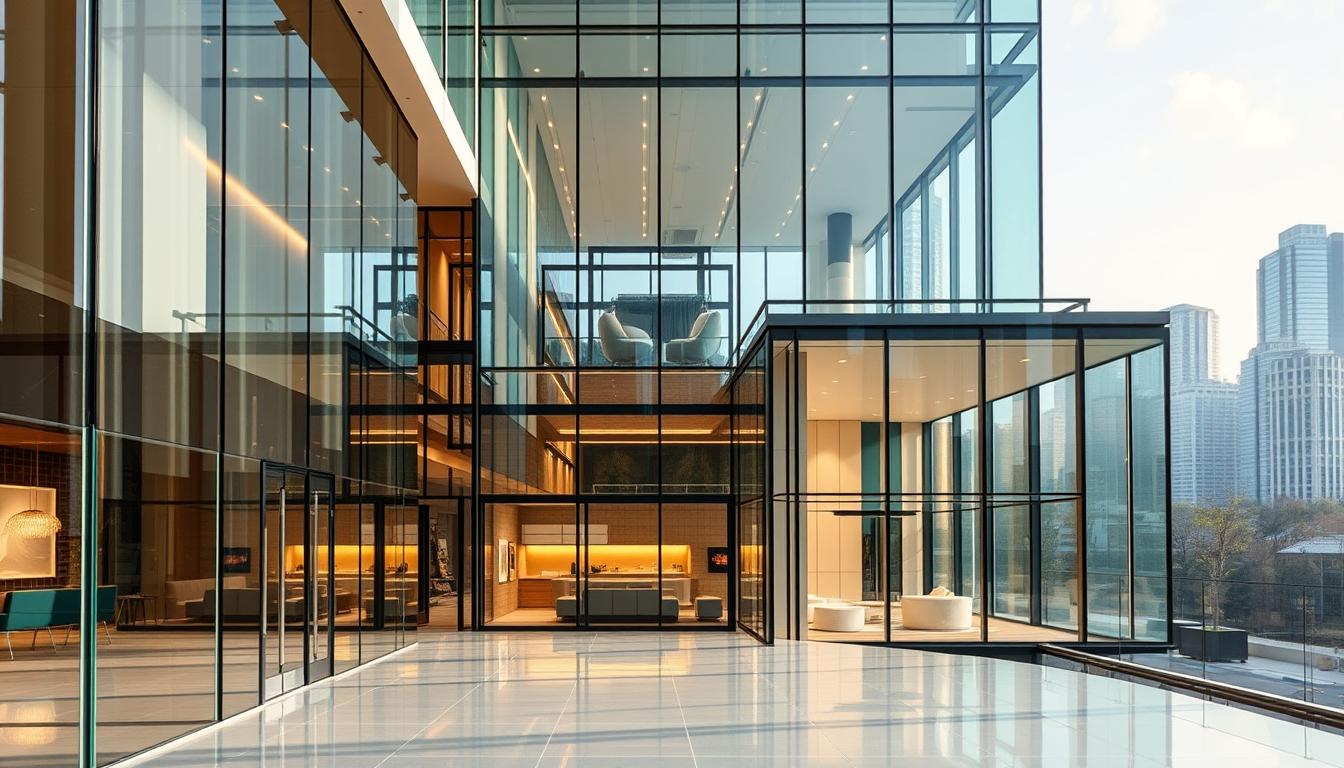The 1970s were a time of big change in interior design. They saw bold experimentation and the start of new styles that still shape today’s decor. These styles were known for earthy tones, organic shapes, and functional layouts. They brought a new way of living and interacting with our homes.
Looking back, we see that vintage interior design still has a big impact. It mixes well with today’s trends, creating unique and lasting interiors. We see old trends coming back in today’s design. This includes the use of natural materials and adding vintage furniture pieces.
Key Takeaways
- The 1970s were a pivotal time for interior design, marked by experimentation and new styles.
- Earthy tones, organic shapes, and functional layouts defined 70s home interiors.
- Vintage interior design continues to influence contemporary decor.
- Retro decor trends are being incorporated into modern design.
- Natural materials and vintage furniture are making a comeback.
The Essence of 70s Home Interiors
The 1970s were all about mixing natural elements with bright colors. This decade was a time of big change and self-expression. People showed this in their home decor.
Key Characteristics of 70s Design
The 1970s decor was a blend of mid-century modern influence and cozy textures. Wood, stone, and leather were popular for their comfort and real feel.
Some key features of 70s design are:
- Use of natural materials
- Bold patterns and vibrant colors
- Focus on comfort and coziness
- Adding retro and vintage touches
The Role of Color in the 70s
Color was very important in 70s homes. Bold accent colors made rooms pop, while earthy tones made spaces feel warm and inviting.
| Color Category | Popular Colors | Usage |
|---|---|---|
| Earth Tones | Brown, Beige, Taupe | Walls, Furniture |
| Bold Accents | Avocado Green, Harvest Gold | Accent Walls, Appliances |
| Vibrant Hues | Turquoise, Burnt Orange | Decorative Items, Textiles |
Textures and Materials of the Era
The 1970s loved natural textures and materials. These added warmth and depth to homes. From shag carpets to wooden furniture, textures were key to the decade’s look.
Some favorite textures and materials were:
- Shag carpets and rugs
- Wooden furniture and paneling
- Leather upholstery
- Woven fibers and macramé
Understanding these elements helps us see why 1970s decor is still loved today. It shows how the past influences our homes now.
Popular Color Palettes from the 1970s
In the 1970s, homes got a fresh look with earthy tones and bold colors. This era’s design was all about unique colors. They played a big role in shaping home aesthetics.
Earth Tones and Warm Hues
Earthy tones like terracotta, mustard yellows, and olive greens were big in 1970s design. These warm colors made homes feel cozy and welcoming. They were used on walls, furniture, and decor, creating a natural look.
Key Earth Tones:
- Terracotta
- Mustard Yellow
- Olive Green
- Sienna
Bold Accent Colors
Bold colors like teal, orange, and yellow added energy to spaces. They were used in statement pieces or as accent walls. These colors made rooms lively and dynamic.
Popular Bold Accent Colors:
- Teal
- Orange
- Yellow
- Burnt Orange
The Impact of Avocado Green
Avocado green was a standout color of the 1970s. It was used in kitchens, bathrooms, decor, and furniture. This color gave homes a unique retro look, blending well with earthy tones.
| Color | Common Uses | Impact |
|---|---|---|
| Avocado Green | Appliances, Decor, Furniture | Added a retro touch, blended with earthy tones |
| Terracotta | Walls, Flooring, Decor | Created a warm, cozy atmosphere |
| Teal | Accent Walls, Furniture | Injected vibrancy, added a pop of color |
To bring 1970s colors into today’s decor, mix retro with modern. Start with bold colors on walls or furniture. Then, add neutral tones to keep things balanced. Or, use earthy tones in furniture and decor for a cozy feel.
Iconic Furniture Styles of the 70s
The 1970s furniture scene was full of diverse and vibrant styles. From mid-century modern to chunky sofas, it was a time of big change. This era’s furniture still excites interior design fans today.
Mid-Century Modern Influence
The mid-century modern style greatly influenced 1970s furniture. It was known for clean lines, organic shapes, and focus on function. Designers like Charles and Ray Eames made this style famous with their creative use of materials and sleek designs.
The Rise of Chunky Sofas and Bean Bags
Chunky sofas and bean bags were big in the 1970s. They were all about comfort and fit the era’s laid-back vibe. The chunky sofa, with its soft upholstery and square shape, was a hit for cozy living rooms.
Statement Pieces: Coffee Tables and Chairs
Coffee tables and chairs were more than just furniture in the 1970s. They were statement pieces. Coffee tables had unique shapes and materials, like glass and chrome. Chairs were bold in color and pattern, adding personality to rooms.
| Furniture Piece | Characteristics | Influence |
|---|---|---|
| Mid-Century Modern Sofas | Clean lines, organic shapes | Influenced modern minimalist designs |
| Chunky Sofas | Oversized, plush upholstery | Popularized cozy, casual living rooms |
| Bean Bags | Casual, comfortable, versatile | Reflected the era’s relaxed lifestyle |
Adding these iconic furniture styles to our homes brings a retro vibe. It honors the design innovations of the 1970s. Whether it’s a vintage armchair or a chunky sofa, these pieces inspire today’s interior design.
Essential Lighting Trends of the 70s
The 1970s were all about bold and sculptural lighting fixtures. This decade’s lighting was more than just functional. It added character and ambiance to rooms.
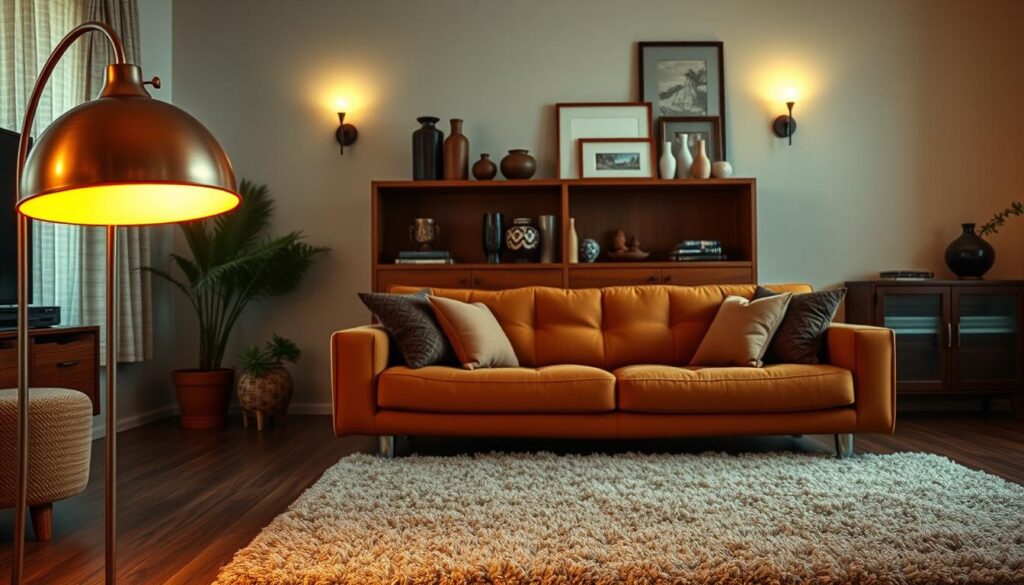
Lava Lamps and Mood Lighting
Lava lamps were a big part of 1970s decor. They offered a mesmerizing display of colorful, gooey textures. This created a soothing ambiance.
Lava lamps and other mood lighting fixtures were key to creating a groovy vibe. Today, many people still use lava lamps in their homes to bring back that nostalgic feel.
Unique Chandeliers and Fixtures
The 1970s were known for their bold and innovative lighting designs. Unique chandeliers and fixtures were a hallmark of the era. They often featured unconventional materials and shapes.
- Sputnik chandeliers, with their multiple arms and bulbs, were a popular choice.
- Globe lights and other spherical fixtures added a retro touch.
- Macramé and other textile elements were often incorporated into lighting fixtures.
Incorporating Track Lighting
Track lighting was another significant trend in 1970s lighting design. It offered a flexible and modern way to illuminate spaces. Homeowners could direct light exactly where it was needed.
Track lighting was popular in kitchens and living areas. It was used to highlight specific features or create a sense of drama.
Incorporating track lighting into your home decor can be a great way to achieve a retro look. By choosing the right fixtures and placement, you can add a touch of 1970s style to your home.
The 70s Kitchen: Heart of the Home
The 1970s kitchen was a lively space filled with bold designs and colorful appliances. It was more than a place to cook. It was where families came together and made memories.
Trends in Kitchen Layouts
In the 1970s, kitchens became more open and functional. Kitchen islands and peninsulas became popular. They improved the flow and made the kitchen a social hub.
If you want a 1970s vibe in your kitchen, try an open layout. Remove walls or add a kitchen island to create a space for gathering.
Appliances: A Splash of Color
1970s kitchens were known for their bold, colorful appliances. These appliances were more than just tools; they were a statement. Colors like avocado green, harvest gold, and burnt orange added vibrancy.
To bring 1970s style to your kitchen, think about using retro-colored appliances. Or, give your current appliances a retro look. It’s a fun way to add color and personality.
Flooring and Backsplash Ideas
1970s kitchens featured a mix of materials and patterns. Linoleum was popular for its durability and ease of cleaning. Natural stone and ceramic tiles were used for backsplashes, often in bold designs.
| Material | Characteristics | 1970s Style Tips |
|---|---|---|
| Linoleum | Durable, easy to clean | Use in bold patterns and colors to make a statement. |
| Natural Stone | Timeless, elegant | Pair with earthy tones to enhance the retro feel. |
| Ceramic Tiles | Versatile, colorful | Choose bold, geometric patterns to capture the 1970s essence. |
For more inspiration, check out these vintage photos of 1970s kitchens.
Reviving 70s Wall Art and Decor
The 1970s were a time of freedom in home decor. This era was known for its bold and eclectic wall art and decor. It celebrated creativity and individuality.
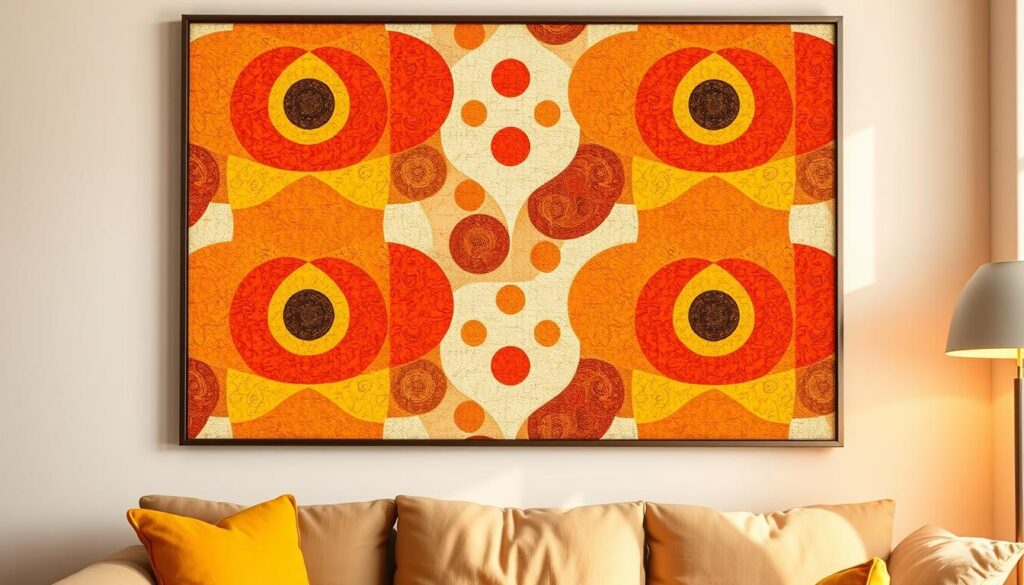
Popular Artwork and Prints
The 1970s loved psychedelic and nature-inspired artwork. This reflected the era’s cultural and social movements. Posters, prints, and paintings used vibrant colors and abstract designs.
- Psychedelic patterns and bright colors
- Nature-inspired themes, such as floral motifs
- Abstract art pieces that added a touch of sophistication
Use of Mirrors and Wall Hangings
Mirrors and wall hangings were big in 1970s decor. Large mirrors made rooms look bigger. Wall hangings, like woven baskets or macramé pieces, added texture and interest.
- Mirrored walls for a sense of spaciousness
- Woven wall hangings for a natural, earthy feel
- Macramé wall hangings that showcased craftsmanship
Embracing Macramé and Textiles
Macramé, a type of textile, was a big deal in 1970s decor. Wall hangings, plant holders, and other items made from macramé or woven fibers added warmth and coziness.
- Macramé wall hangings and plant holders
- Woven wall baskets for storage and decoration
- Tapestries and other textile art pieces
By adding these elements, you can bring 1970s retro style to your home. It celebrates creativity and self-expression.
Flooring Choices in 70s Interiors
The 1970s were all about new and different flooring choices. This decade mixed old and new materials. This led to many styles that made homes unique.
Carpet Trends and Patterns
Carpets were key in 1970s homes, adding warmth and comfort. Shag carpets were very popular, with their thick piles and bright colors. They made rooms feel cozy and textured.
There were many patterns, from geometric to abstract. These let homeowners show off their style.
Linoleum vs. Hardwood
In the 1970s, people debated between linoleum and hardwood floors. Linoleum was made from natural stuff like linseed oil. It was durable and easy to clean.
Hardwood flooring, on the other hand, was seen as luxurious and timeless. Linoleum was practical, but hardwood was chosen for its beauty and value.
The Return of Shag Rugs
Shag rugs became popular again in the 1970s. They were loved for their soft piles. These rugs warmed up rooms and made a bold statement.
Today, we can bring these retro touches into our homes. They add a vintage touch to modern spaces.
Learning about 1970s flooring helps us with our home makeovers. Whether it’s the softness of shag carpets or the beauty of hardwood, these trends still inspire us today.
70s Bathroom Retreats
Step into a 1970s-style bathroom, and you’ll feel like you’ve traveled back in time. These bathrooms were known for their funky decor and nostalgic charm. They still inspire retro furniture and home decorating today.
Colorful Fixtures and Vanities
The 1970s bathrooms were famous for their colorful fixtures and vanities. You’d see avocado green, harvest gold, and sky blue everywhere. These bold colors made the bathroom a standout room in the house.
- Avocado green and harvest gold appliances were very popular.
- Sky blue and soft pink were used to create a calming feel.
- Vanities often had ornate mirrors and fancy lighting.
Tile and Sink Trends
The 1970s had unique trends in bathroom tiles and sinks. Geometric patterns and floral motifs were big, adding interest to walls and floors. Sinks were often in vanity units, becoming a key part of bathroom design.
- Ceramic tiles with geometric patterns were used.
- Floral motifs were seen on tiles and wallpaper.
- Wall-mounted sinks with decorative brackets were common.
The Influence of Retro Showers
Retro showers were a big deal in 1970s bathrooms. They often had shower curtains with bold prints or colorful tile work. Shower stalls with framed doors were also popular, adding to the retro look.
To bring this retro charm into today’s bathrooms, consider these ideas:
- Bold, graphic shower curtains.
- Colorful tile work or mosaic designs.
- Retro-style shower heads and fixtures.
Outdoor Spaces: 70s Garden and Patio
In the 1970s, outdoor spaces were more than just an extension of the home. They showed the era’s love for nature and comfort. The decade focused on making outdoor areas both useful and beautiful, often using hippie chic decor and mid-century modern influence.
Designing a Retro Outdoor Oasis
To make a retro outdoor oasis, think about 1970s design. Use natural materials like wood and stone. Also, add vibrant colors and patterns. The goal was to make the outdoors feel like part of the home.
“The great outdoors was being brought into the home, and vice versa,” designers said. This was done with large sliding glass doors, outdoor kitchens, and dining areas. These elements made the outdoors feel as cozy as indoors.
Furniture for Outdoor Living
Furniture was key in 1970s outdoor spaces. The era loved comfort and practicality, with wicker and rattan furniture leading the way. These materials were natural, durable, and easy to care for.
- Wicker and rattan furniture
- Bold, colorful cushions and upholstery
- Hammocks and swing chairs
Outdoor furniture was more than just useful; it made a statement. It often had bold, colorful cushions and upholstery, adding to the space’s look.
The Power of Indoor/Outdoor Flow
The 1970s blurred the lines between indoors and outdoors. Designers used big windows and sliding doors. They also used similar materials and decor inside and outside. This indoor/outdoor flow made spaces feel connected and bigger.
“The outdoors is not just a place to be seen from, it’s a place to be in.” This idea guided 1970s outdoor design, making it a key part of the home.
By following 1970s design, homeowners can make outdoor spaces that are both nostalgic and modern. Use natural materials, bold colors, and comfy furniture. The essence of 1970s outdoor decor can enhance today’s homes, making them more appealing and livable.
Bringing 70s Style into Modern Homes
The 1970s were known for their bold and eclectic style. Now, we’re seeing this style come back in modern home decor. To bring 70s style into your home, mix retro flair with contemporary chic.
Blending Contemporary and Retro Elements
Mixing old and new is an art. Start by adding one or two retro pieces to your modern space. A vintage armchair or a retro-patterned rug can add 70s charm to your living room.
To not overwhelm the space, balance your retro pieces with modern ones. For example, pair a vintage sofa with a sleek, modern coffee table. This mix creates a beautiful blend of old and new.
Key Pieces to Invest In
For a retro furniture revival, focus on these key pieces:
- A vintage or vintage-inspired sofa with a bold, geometric pattern
- A retro-style armchair with a funky, colorful design
- A wooden coffee table with a unique, sculptural shape
- A macramé wall hanging or plant holder for a bohemian touch
These pieces will help you build a solid 70s-inspired decor foundation.
DIY Ideas for a 70s Touch
For a 70s touch without spending much, try these DIY ideas:
- Create retro-inspired wall art with vintage prints, posters, or photographs
- Upcycle an old piece of furniture with fresh paint or new hardware
- Make a macramé plant holder with cotton rope and simple knots
- Add color with vintage-inspired throw pillows and blankets
These DIY projects can help you achieve a groovy 70s style without breaking the bank.
By mixing old and new, investing in key retro pieces, and doing DIY projects, you can bring 70s style to your modern home. With creativity, you can make a unique and stylish space that honors the past while feeling modern.
Resources for 70s Home Decor Inspiration
Looking to add vintage charm to your home? There are many resources to explore. We can find inspiration in the 1970s to make our homes unique.
Pioneers of 70s Design
Designers like Charles and Ray Eames were key in the 1970s. They used new materials and focused on function. Their work still inspires those who love hippie chic decor today.
Recommended Reading and Viewing
Want to learn more about 70s design? Check out books and magazines from that era. House Beautiful and Architectural Digest often have retro interiors that spark creativity.
Online Communities and Vintage Shopping
Join online forums and social media groups for vintage design. You can also find real retro decor in vintage shops and online. This helps us add authentic touches to our homes.
